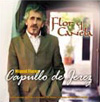PURITY WITHOUT PAIN
| Text: Estela Zatania
Miguel Flores Quirós, «Capullo de Jerez», at 53, is the idol of a large portion of young flamenco fans. It’s not exclusively an audience that goes in for «lite» flamenco; Capullo followers are also to be found among serious cante aficionados who see in him a type of purity that is his, and his alone, not the kind you see in books or hear at flamencologists’ conferences. It’s the authenticity that comes from growing up on the Calle Nueva in Jerez, from a mother who sang, and from a dynamic era when cante still existed as a way of life. Capullo is a charismatic and creative singer who, thanks to his artistic honesty and background, manages to connect with a diverse audience. Were that not the case, he cound never have set thousands of people rocking at the last Fiesta de la Bulería held in the immense Jerez sports stadium. Once a cult figure, he has now moved beyond and become a major star. With this recording the singer remains true to his line, and even defines it more clearly, rejecting the superficiality others resort to in order to satisfy the demand for derivative flamenco music without complications.It’s not that Capullo doesn’t have a repertoire based on the most popular sort of flamenco, but he interprets it with passion and knowledge.
The CD opens with a rumba, «Son de Lunares», where the mix of instruments, choruses and overall structure, is reminiscent of the 1980’s, a time when Capullo was finding his artistic personality, so he manages to make it valid despite the passage of time – honesty is always yields results. Equally authentic is the bulería «Perdón» which follows.He cooks up his Jerez-flavored recipe with the support of Diego Amaya, Niño Jero and Jerito on guitar, and the sound of Joaquín Grilo dancing. It’s essentially a bulería pop song, but with this singer the frontier between pop and flamenco blurs thanks to his way of constructing the melodies (composed by the singer himself, as are the lyrics), his very flamenco phrasing and of course, his way of traveling through the compás. «Flor y Canela», the title song of the CD, is a composition set to laidback tangos with a certain feeling of contemporary pop music, without being definable as a «commercial concession», because Capu, as his diehard followers call him, concedes nothing, and knows how to win over audiences showing himself exactly as he is. He has the enviable capacity to surprise interpreting the same repertoire as always: bulerías, tangos, rumbas and fandangos. In fandangos, he holds nothing back in styles reminiscent of Niño de la Calzá, but with the personal touch that always characterizes this singer. In the upbeat tango «La Culpa», the singer’s admiration for El Barrio comes to the surface, an influence which is assmilated and employed to great effect; Selu’s placid Bing Crosby delivery manages to temper Capu’s aggressive approach. This leads to soleá por bulería, the anarchic form which is preeminently flamenco and pure Jerez, and which is made-to-order for this singer who knows how to take full advantage to express his own personal vision. The bulería «Las Flores» has a feeling that yearns to be a rumba, but there’s still Capullo’s famous rumba, the one his fans chime in singing at his concerts, «Pan y Queso». The CD closes with what has become an almost obligatory finish for Jerez singers: the improvised bulerías finale without guitar, a capella. Recorded at a gathering-place outside town to avoid the sterility of a recording studio, it’s seven well-rounded minutes of Capullo facing the challenge. The palmas or handclaps barely sound, rhythm soaks the air and Capullo delivers his own private fiesta, the one that’s going non-stop in his head at all times and to which he makes us accomplices. About half-way through, the singer finds that high level of intensity that suits him so well.Selecting cantes with taste, his voice breaks again and again, the play of syllables and re-pe-ti-re-pe-ti-tions, then suddenly evoking the voice of La Perrata and lastly, a verse about strolling down Nueva and Cantarería streets in the early dawn with Camarón alongside murmuring «Capullo, Capullo». Purity without pain, his own special kind. |
